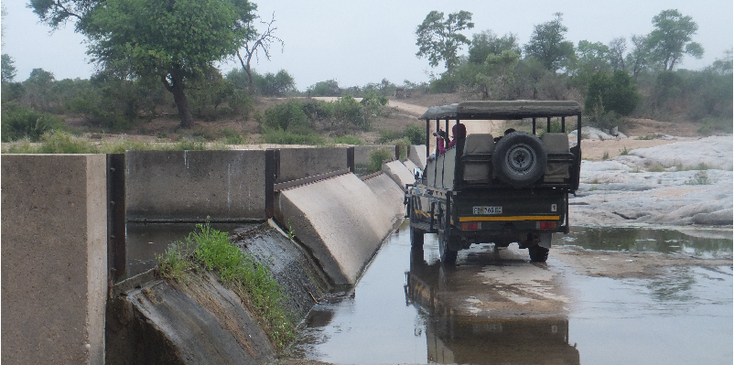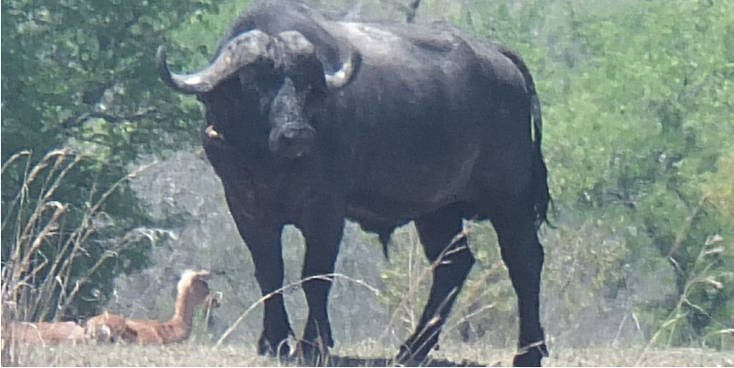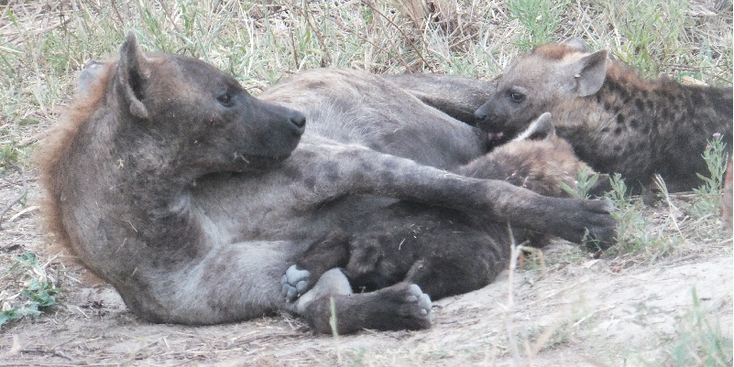Kruger National Park
Tours - South Africa

introduction
The Kruger Park is, like Mandela, the national symbol the springbok and the table mountain one of the symbols of South Africa. Kruger is one of the largest wildlife parks in the country and even continent and is located on the border with Zimbabwe and Mozambique. The park attracts hordes of national- and international tourists and is teeming with wildlife.
There are no less than nine gates and there is a network of gravel and asphalt roads through the park. It is possible to go Kruger with your own car but of course you can also visit the park with a tour (daytrip) and book a jeep safari in the park itself. Finally, there is the possibility to walk with a ranger on foot in the park. There are several encampments in the park and you can stay in both a five star guesthouse as well as in your own tent.
history

It was the Bushmen who took the first steps in the current savannah what we now call Kruger park. You can find old petroglyphs of the San people in parts of the park. Around 500 BC there would be several Bantu-speaking tribes withdrawing from the area during the great African migration. Their most famous establishment was that of Thulamela that flourished between the 16th and 17th century. Because of the increasing hunting with increasingly modern weapons, the need for protection of nature in general and wildlife in particular arose at the end of the nineteenth century.
The people's council of the South African Republic (Transvaal) therefore prohibited the hunting between the Sabie and the Crocodile River. In 1898, President Paul Kruger of the former ZAR Republic proceeded to the establishment of the Sabie Game Reserve. Shortly afterwards, the Second Boer War (1899-1902) broke out, as a result of which nature protection did not get much more attention. In 1903 - Transvaal had meanwhile become a British colony after the lost war - the British Major James Stevenson-Hamilton became the first main field guard of the area. He was a passionate nature lover and devoted himself to expanding the area.
Year after year, more and more areas came under the umbrella of the reserve. In 1916, a railway was built, allowing the general public to reach the park more easily and making it more interesting for tourists. A third milestone was reached in 1926, when UZA minister of Lande Piet Grobler decided to establish the first national park in South Africa. It was named after one of the founders of the park, Paul Kruger. Unfortunately, large parts of the park (between 20 and 50%) are still claimed to be the land of someone else. Kruger has become a very important conservation and research center.
For some years the park has been part of the larger border Limpopo Oorgrens park, which also includes parks located in Mozambique and Zimbabwe. Unfortunately, hundreds of rhinos had to be transferred to other parts of the park and even other national parks in South Africa and surrounding countries because of the large number of poachers that are active because of the precious horn. In Asia, this is used in various medicaments and applications because of their supposed magical power.
kruger park
The Kruger Park is 380 km long, 60 km wide and has a total area of approximately 20,000 km². Besides the actual park there are countless game reserve parks attached that you can also visit. The park contains 25 (camping)camps, including 12 large camps such as Skukuza, Lower Sabie and Satara.
All camps are fenced off. Only in these camps, and at designated places such as picnic areas such as Tshokwane, visitors are allowed to leave the car. Unique is the park because you can drive around in your own car. There are even certain pieces of really rough terrain where you can only drive with 4WD - you can book this before you go to Kruger. Lebombo Motorized Eco Trail is the best known and longest of these and runs parallel to the eastern boundary of the park.

Number of (wild) big animals:
- 1,600 lions;
-
8,800 rhinos (white);
-
7,700 giraffes;
-
13,000 elephants.
In addition to the size, this park is also known for the large variety of animal species. The so-called Big Five are the most famous of these: the lion, the buffalo, the leopard, the rhinoceros and the African elephant. Of the latter, the largest population in the world lives in the Kruger Park. In addition to these five animals, there are also many others, such as the giraffe, hippo, kudu, impala, wild dog, zebra, cheetah, hyena, crocodiles, baboons and various bird species.
Several rivers flow through the park where the Sabie River and the crocodile river are the best known. The park also has more than 300 archaeological sites, such as Masorini and Thulamela. These archaeological sites date from the Stone Age, the Iron Age and from the time of the Bushmen (San).

to visit
You can park in different ways - you can book a day trip from hostels, hotels and information centers in the surrounding cities (Nelspruit and for example Hazyview). These usually include the entrance fee, meals and transport for about 800 to 1000R per person. You can also book online or just drive to the park in the hope that there is still a place (this is not recommended as the popular sites are quickly taken).
Besides a safari in your own car or in tour (jeep) you can also walk in the park. The wilderness walks are often three days and must be booked in advance due to their popularity. Count on more than 3000R for three days including a guide, meals and overnights in Spartan huts. You walk about 20 km per day and should be able to do with a person who does average exercise at home.
overnight options:

Within the park there are various possibilities to stay overnight. Firstly, you can stay in one of the private game parks that lie next to Kruger. If this becomes too pricey you can stay overnight in one of the many rest camps. These are all fenced (with electric fence) and you can rent a cabin here as well as a tent (or with your own tent). These camps usually have one or more satellite camps. Skukuza is the largest rest camp (see below).
A bit more adventurous are the bushveld camps. There are five in the Kruger and are more "self catering". Here are fixed cabins and cottages and are a lot smaller than the "rest" camps. They are also a lot more remote but are also a lot more pricey. "Bush" lodges must be booked in their entirety and is a great option for a family or group. There are two of these possibilities in the park. Finally there are the "shelters" where you can only enter half an hour before darkness and half an hour after the light has to leave. You have to bring your own wood and the maximum person is six.
Administration and reservations
You can reserve a spot in the Kruger park online, by telephone or in person.
National Parks
643 Leydts street, Muckleneuk, Pretoria
Reservations: +27 (0) 12 428 9111
Lowveld Tourism
Nelspruit or Cape Town office
Cost:
-
Entrance Kruger = 265R per day per person;
-
Camping Skukuza = 280R per day per person (+ 75R for extra person).

Skukuza camp
The largest camp of Kruger is the centrally located Skukuza rest camp. It is the park's administrative center and is located on the Sabie river. There is a bank, cash machine, shop (with daily necessities but also souvenirs), gas station, library, swimming pool, post office, restaurant, police station, museum and an information center. You can camp here but also rent a house or even an "upgrade" bungalow.
PAY ATTENTION:
The gate of the camp opens when it becomes light (05:30) and closes at 18:00; if you are later you will get a fine.
Activities Skukuza camp:
Name: Sunrise tour
Price: 242R
Duration: 3 hours
Name: Sunset drive
Price: 242R
Duration: 3 hours
Name: Night drive
Price: 207R
Duration: 2 hours
Name: Bush walk (in the morning)
Price: 455R (incl light snack)
Duration: 3 hours
Name: Bush walk (in the afternoon)
Price: 350R
Duration: 2 hours

tips
-
Always take something warm when you go on a tour; the windows are often open and the temperature varies a lot and changes quickly;
-
Drive a combination of asphalt and gravel to keep it "nice" and “diverse”;
-
Most rhinos are spotted at Berg en Dal;
-
In the summer you can spot animals because they go to water pools; in the rainy season the grass is high and the vegetation is dense so that you can hardly spot anything;
-
Do not forget to bring sunscreen, sunglasses and headgear;
-
In South Kruger the amount of animals is a lot bigger than in the north;
More tips:
-
Look in big trees for leopards;
-
Spot among trees (especially when it gets hot) lions and cheetahs;
-
Early in the morning (when the light comes - 05:00 am) most animals are active and you can spot them best;
-
In the case of water ponds, most animals come together where most animals come together (to hunt and to drink);
-
Along the Sabie river numerous elephants are grazing in large quantities;
-
Bring binoculars to spot wild animals from a distance;
-
Without prey no wild animals, so watch if impala’s and other hooved animals react nervous and the chance that there is a predator in the neighborhood is big.

see also:
LANDEN:
EUROPA:
Albanië * België * Bosnië-Herzegovina * Bulgarije * Denemarken * Duitsland * Engeland * Estland * Finland * Frankrijk * Griekenland * Hongarije * (Noord) Ierland * Italië * Kosovo * Kroatië * Letland * Litouwen * Luxemburg * Macedonië * Malta * Montenegro * NEDERLAND * Oekraïne * Oostenrijk * Polen * Portugal * Roemenië * Rusland * Schotland * Servië * Slovenië * Slowakije * Spanje * Tsjechië * Turkije * Zweden
NOORD EN CENTRAAL-AMERIKA:
Chili * Costa Rica * Cuba * Guatemala * Mexico * Nicaragua * Panama * Verenigde Staten
ZUID-AMERIKA:
Argentinië * Bolivia * Brazilië * Colombia * Ecuador * Peru
AFRIKA:
Botswana * Burkina Faso * Egypte * Ethiopië * Ghana * Kenia * Mali * Marokko * Namibië * Oeganda * Senegal * Tanzania * Tunesië * Zuid-Afrika
MIDDEN-OOSTEN:
Iran * Israël * Jordanië * V.A.E.
AZIE:
Armenië * Cambodja * China * Filipijnen * Georgië * India * Indonesië * Japan * Kirgizië * Laos * Maleisië * Mongolië * Myanmar * Nepal * Oezbekistan * Singapore * Sri Lanka * Thailand * Vietnam
OCEANIE:
Voor meer reisfoto's kijk op www.instagram.com/cheapskatetravel.nl:
© Cheapskatetravel.nl; 2009 (all rights reserved)


